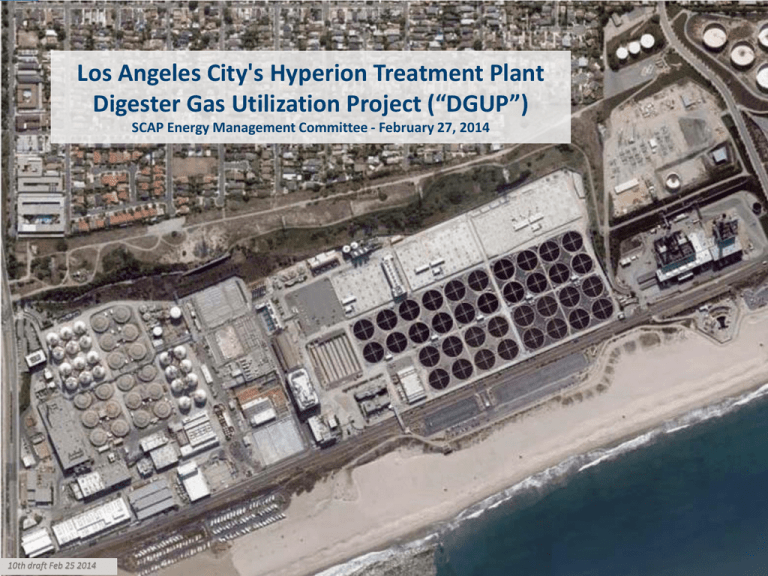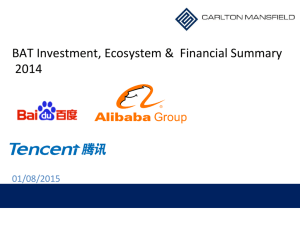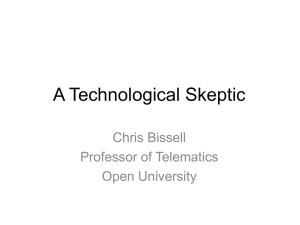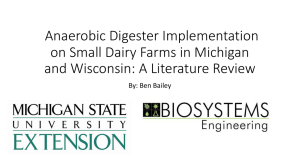10th draft Feb 25 2014
advertisement

Los Angeles City's Hyperion Treatment Plant Digester Gas Utilization Project (“DGUP”) SCAP Energy Management Committee - February 27, 2014 10th draft Feb 25 2014 HYPERION TREATMENT PLANT – EXISTING USE OF DIGESTER GAS SINCE 1995 LADWP SGS 1/2 Steam HTP Boundary Natural Gas Digester Gas Solids Treatment Class A Biosolids Kern / TIRE Wastewater Primary & Secondary Treatment Reuse Ocean 10th draft Feb 25 2014 2 Current generation and Utilization of Digas 3 DGUP: PROJECT HISTORY Year Description 1995 Scattergood-Hyperion Electrical Energy Exchange Agreement: 7-MSCFD digester gas (renewable energy, 15.5MW) DWP SGS electricity HTP at fixed rate . . . Has high DG associated emissions 2001 Steam Agreement 2003-07 SGS: 2007-09 SHARE: DWP financed/operated cogeneration project at HTP using digester gas 2009 DWP: 2010 SHARE: Abandoned by DWP 2010-11 Alternatives considered / financing constraints 2011 DGUP RFP: Best use of HTP digester gas considering technical performance and cost with “alternate delivery.” BOS willing to consider alternative solutions 2011-12 GFE: 2012 Contract Selection: Cogeneration as best value (Constellation Energy) 2012-13 CEQA/EIR: 2013 Current Contract Structure: addresses ownership, financing, DWP 2014 DWP: Agreement Extended to 2017 2014 Contract Approved: January 2014 Next 3 yrs Commercial Operation: Before December 31, 2016 Technical obsolescence, cooling water issues, market issues . . . . Notice to Terminate agreements in 5 years (flaring, Costs: $8M/yr +$30M/yr) Complicated issues resolved November 2013 4 Why DGUP? There are underlying economic factors Source: EIA 5 DWP ENERGY RATE TRENDS (HTP CURRENTLY PAYS $0.05/KWH) Cost of Electricity from the “GRID” 21MW-hr x 1000kw/MW x 24hr x 365d/yr x $0.18/kw-hr = $33,000,000/yr Each $0.01/kw-hr increase impact HTP by $1,800,000/yr HTP Energy Costs (of annual budget): 10% (now) +30% (2017) 6 HTP Location: Complex Environmental Situation CALIFORNIA COASTLINE PROJECT HTTP://WWW.CALIFORNIACOASTLINE.ORG/CGI-BIN/IMAGE.CGI?IMAGE=200802433&MODE=SEQUENTIAL&FLAGS=0&YEAR=2008 7 HYPERION: ELECTRICAL DEMAND LAST 6 YEARS IN 2009-10, I PREDICTED A SIGNIFICANTLY DIFFERENT TREND Demand has gone down Use has improved Constraints will change in the future 1-week average demand HTP-elect load-8-29-13 8 Politics Real World Issues Electric cost Many Stakeholder-specific Project Drivers Natural gas costs/volatility Imposed Time Constraints Electrical growth Digas production – volume and quality City Policies Emissions City was Open to Alternative solutions Capital costs 9 PROPOSALS (IN RESPONSE TO 2011 RFP) • 10 proposals with 2 general approaches: • Bio-methane • Ameresco • BioFuels • Southern California Gas • Co-generation • Ameresco • NORESCO • Constellation • Southern California Gas • DTE • UTS • DCO 10 PROPOSAL EVALUATION PROCESS RFP SECTION 9 Ameresco (1&2) BioFuels Constellation DCO DTE NORESCO Southern California Gas (1&2) UTS 10/12 3/11 8/12 Initial Screening (GFE) Preliminary Evaluation Constellation DCO NORESCO 11/12 1. Constellation 2. NORESCO 3. DCO Proposals BioFuels So.Cal.Gas DTE So.Cal.Gas Shortlisted Projects Final Evaluation Select “Best Value” Project Ameresco (2) UTS A multi-step, comprehensive process . . .Evaluated both cost and non-cost factors 11 DGUP PROJECT - SUMMARY • Selection addresses the plant’s electricity and steam needs • Utilizes 100% of digester gas, and • Generates up to 29 MW • Generates all the steam required for solids treatment • Uses existing resources • Addressed environmental concerns: • air emissions and health risks • noise • no flaring of gas, except during emergencies • Capability of “islanded” operation during emergencies • Slight export of power, significantly reduces potential demand charges • Potential growth (digas, electricity, steam) and flexibility (fuel) • Alternative Delivery – time was main factor Overall: Technical + Cost “Best Value Project” 12 DGUP: SYSTEM CAPACITY VS. HTP DEMAND Guarantees System will meet demand > 95% of time. HTP-elect load-8-29-13 13 CONSTELLATION Summary • • • • Two Mars 100 units w/ HRSG, w DF, w/STG ~25 MW normal output Future: 1 Mars 14 14 Gas Treatment NSY CoGen Area HTP – ERB FROM SOUTH – VIEW, FROM BING DGUP PROJECT HYPERION TREATMENT PLANT 15 DGUP: Demolition will be an early task 16 HTP DIGESTER GAS UTILIZATION PROJECT OVERALL TIMELINE (ESTIMATED 2/13/2014) Complete CEQA/EIR NTP Complete Demo Selection DGUP RFP Complete Design “SHARE” Start Testing Commercial Operation & “Final Acceptance” City Starts Operation DWP/BOS Agreement 1995 2007 City Starts Training 2011 2012 2013 2014 2015 2016 2017 2025 2026 DWP/BOS “partnership” Procurement Design Construct CEQA Test LADWP Energy Agreements/Partnership Operation Cogeneration 17 Questions 18 • HTP • One of largest plants in the world T-3 • Located in El Segundo . . . Next to Dockweiler, butterflys, airport • Reliably treats water to high standards • Treats and manages bio-solids for beneficial use • WWTP by-product, Digester Gas, renewable energy resource at SGS • DWP Provides 20 MW (on average) • DWP Provides 35,000 lb/hr steam • Provide extremely reliable electricity and steam source • Energy Costs: $8 to 9 Million/year 19 HTP Digester Gas – Some Reference Numbers • Gas Production Rate: 7 MSCFD • The generation of the digester gas is expected to increase by 30% over the next 5 years. T-3 • Energy Content: 1.5 x 1012 btu/yr • Potential Renewable Value: $tbd • Current HTP Budget: $77-80 M/yr • Current HTP Electric: $5.2M/yr will go to +$30M/yr w/ no project • Current HTP Steam: $2.9M will go to $tbd M w/ no project • Renewable Electricity 15 MW now 18 MW or depending on the math 20 • Why DGUP? • LADWP Economics . . . Starting about 2005 . . . . . CHART • HTP electricity from LADWP (about 20.5 MW) • $0.05/kwh now • > $0.19/kwh w/o DGUP after 2016 • About $0.13-0.15/kwh w/DGUP • Because of Regulatory Constraints, SGS is not an option after 2016 • Existing agreements expire January 31, 2015 December 31, 2016 T-5, 6 21 HTP DIGESTER GAS – OPTIONS CONSIDERED T-9 • Option 1: electricity. Power Generation - Use digas to self-generate HTP steam and • Option 2: Sell Digas “as is” - Use digas for plant steam, sell excess digas as a green energy source. Purchase electricity from DWP. • Option 3: Clean Digas/Sell Biomethane - Use digas for plant steam, purify excess digas to pipeline quality, sell as a renewable energy source to make electricity. Purchase electricity from DWP. • Option 4: Clean Digas/Store Biomethane - Same as Option 3, but store gas underground to maximize value. Purchase electricity from DWP. • Option 5: “Do Nothing” - Use digas for plant steam. Flare excess digas. Purchase electricity from DWP. 22 WHAT DID RFP SEEK? T-9 • • • • • • • Reliable source of electricity Reliable source of steam Minimum Environmental impact Small Carbon footprint (renewable fuel) Make best beneficial use of biogas, reduced flaring Schedule that works Affordable Fiscal Impact, considering: DGUP RFP AUTHORIZED JANUARY 2011 – Capital cost – O&M cost • It is unrealistic to get an alternative project operational by January 2015 extension • USE HTP'S DIGESTER GAS TO EITHER: (1) PROVIDE STEAM FOR HTP DIGESTERS AND ELECTRICAL ENERGY FOR CURRENT AND FUTURE PLANT OPERATIONS OR (2) PROVIDE A MONETARY BENEFIT TO OFFSET THE PURCHASE OF ELECTRICITY FOR HTP PLANT OPERATIONS 23 DGUP OVERVIEW • Technical • 7.2 MSCFD digester gas • Very significant energy resource • Low risk, proven technology • 25 MW for HTP • 50-kpph reliable source of steam • Sustainability • Low environmental impact • Renewable Energy: currently 15 MW w/ No project 0 MW w/project (includes steam) 24 MW • Schedule • SGS option ends December 2016 • Startup: October 2016 w/NTP in February • Alternative Delivery • Design & Construction • Startup/Testing • Operation - 10 years operation by Contractor • Best Financial Value to City • Performance based contract • NPV determination over 20 years • Current HTP Budget: • Current Electric/Steam: $77-80M/yr $8.2 M/yr • No project, Electric/Steam: $35 M/yr • DGUP, Electric/Steam: $21 M/yr 24 HTP DIGAS OPTIONS HTP SGS • 1/3 gas to boilers • $3.6M to maintain • 2/3 gas flared • Estimated $15M to generate • Total emissions: ??? • Xxx emissions • $28M direct electrical charge (@$0.16) • Taller stack, remoter location • Upgrades to Flares and boiler required DROP ? 25 ELECTRICAL • Considerations – • Construction cost (uncertainty) • Reliability (relative to today) • Technical risk (future) • Rate Risk (not negotiated yet) • Financial risk (next 20 years) • What benefits BOS, not DWP • Options (premise: any of these are acceptable, pending detailed analysis) A. Connect to Grid (reliability a wash, high cost, best chance for bucket 1) B. Connect to MSY (reliability -, high cost, difficult to implement, good chance for bucket 1) C. Connect to NSY (reliability +, low cost, bucket 1 uncertainty) 26 HTP Digester Gas Utilization Project Project Variables • Electric cost • Natural gas costs– Chart? • Electrical growth – Chart? • Digas production – volume and quality • Capital costs • Emissions • City Policies • Time Constraints • Real World Issues • Politics “I’ll pause for a moment so you can let this information sink in.” • Reliability / Risk 27 PROPOSAL EVALUATION PROCESS • Followed process described in RFP §9 • Evaluation Teams • Included 16 subject-area specialists • 11 different functional areas, including 3 different Bureaus • Over 400 years of combined experience [eval. team] + more on support staff • Management and Consultant review • Equal, Unbiased Assessment of all proposals 28 EVALUATION CRITERIA RFP SECTION 9 1. Technical • Teaming Experience & Financing • Terms & Conditions • Technology • Project Implementation • Project Operation 2. Financial • 20-year “net present value” analysis RFP Defines “Best Value” 29 DGUP Motivation (Best Interests of the City) Constraints: • schedule dictated by external circumstances • limited available funding • possible lack of specialized technical expertise BUREAU decided DBOOT would serve the best interests to realize: • Significantly lower operational costs for steam and electricity for HTP compared to no project, • Improved beneficial use of a renewable energy source compared to current use, and • Lower emissions associated with digester gas flaring as compared to no project. • Shifts substantial technical and financial RISK to Contractor by tying payments to performance requirements . . . . . But • Later had to change ownership to address external requirements . . . . . . . . But this ultimately proved beneficial 30 HTP Digester Gas Utilization Project Purpose of Project • Develop the best beneficial use of digester gas generated at HTP to meet its energy needs by January 2015, considering: • Financing • Demolition • Design • Construction • Operation (as integrated into HTP) 31









